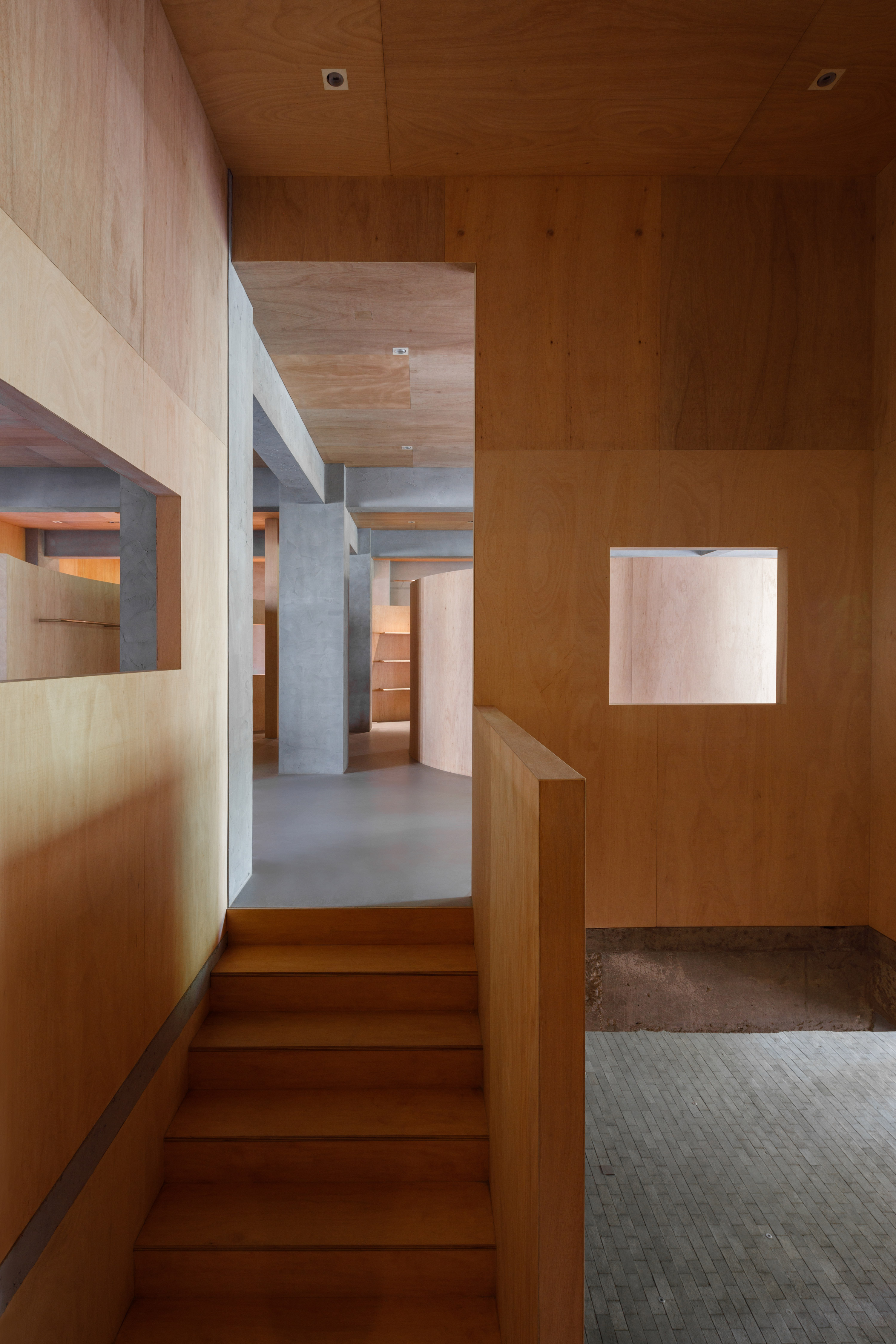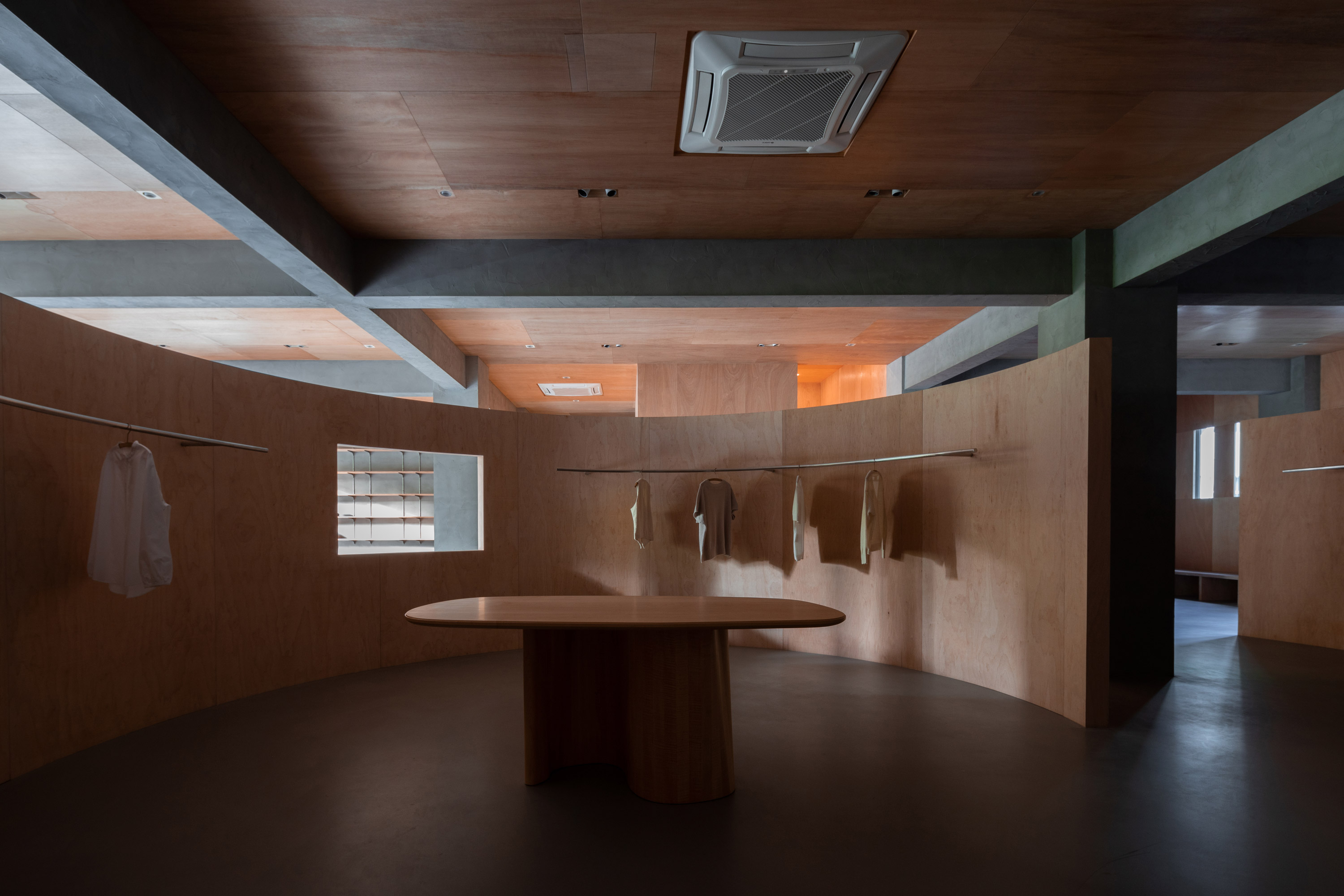
设计单位 MOU建筑工社
项目地点 江苏南京
建成时间 2022年10月
项目面积 600平方米
撰文 吴状
本文文字由设计单位提供。
项目背景与城市脉络
2022年初,工作室受邀为三家生活方式品牌共同设计位于南京的集合店铺。两层共600平方米左右的面积,经过商定,一层为户外生活方式品牌ABC CAMPING COUNTRY,二层则为失物招领×三十六鸥生活提案店。
In 2022, mou architecture studio was invited to co-design a collection of shops in Nanjing for three lifestyle brands. With two floors of around 600 square metres, it was agreed that the ground floor would house the outdoor lifestyle brand ABC CAMPING COUNTRY and the first floor would be a lost&found x 36ou lifestyle proposal shop.

场地选址于南京碑亭巷62号美术大厦,这里是长江路和碑亭巷的交汇处。“一条长江路,半部南京史”,不论是六朝还是民国时期,这两条路都见证了南京历史上的兴衰繁荣。
The location of the venue is the Fine Arts Building, 62 Beiting Lane, Nanjing, where Yangtze River Road and Beiting Lane intersect. "One Changjiang Road, half of Nanjing's history", whether during the Six Dynasties or the Republic of China, these two roads have witnessed the rise and fall of prosperity in Nanjing's history.
悠久的历史必然会在不同时期塑造出城市的不同肌理,我们希望通过此次改造设计,能够捕捉城市的脉络与肌理,让这里不但成为包容各种商品的店铺,也能帮助街道和建筑再次焕发活力,成为居民和来往的顾客聚集、交流的场所。
The long history has inevitably shaped the different texture of the city at different times. Through this renovation design, we hope to capture the pulse and texture of the city, so that it can not only become a shop that embraces all kinds of goods, but also help the street and the building to rejuvenate again and become a place for residents and customers coming and going to gather and communicate.



思考街道与店铺的关系
碑亭巷是一条南北走向不足千米、面宽狭窄的街道,中间设有机动车单行通道和自行车道,道路两侧是人行步道。历史的积淀加上窄街区的舒适尺度,让这里如今成为烟火气十足巷子。
A narrow street running north-south for less than a kilometre, with a one-way motorway and cycle lane in the middle and pedestrian walkways on either side of the road, the historical deposit combined with the comfortable scale of the narrow block makes this a smoky alley today.
美术大厦这栋建筑物坐东朝西,主入口大面积的窗户面向街道。其对面是第一个国家级美术馆,由中国第一代建筑师杨廷宝先生设计建造,透过低矮的围墙我们能看到美术馆的建筑和院子。美术大厦西侧并没有近距离的高大建筑物作为遮挡,因此夏天西晒的问题在设计中需要去应对。我们还注意到,街道两侧的大部分建筑物紧邻着人行步道,因此一些店铺一旦排起长队,势必会挤占人行道。这种情况不但会影响道路交通,而且雨天没有遮蔽,使人更为狼狈。我们关于店铺与街道关系的思考也由此展开。
The building, the Arts Building, faces east and west, with the large windows of the main entrance facing the street. Opposite is the first National Art Museum, designed and built by Mr. Yang Tingbao, the first Chinese architect, whose buildings and courtyard we can see through the low fence. We also note that most of the buildings on both sides of the street are adjacent to the pedestrian walkway, and that long queues of shops inevitably crowd the pavement, which not only affects the traffic on the road, but also makes it even more difficult in the rain when there is no shelter. This has led to a reflection on the relationship between shops and the street.

如果能给建筑安装上大屋檐,既能解决两层空间的西晒问题,底层还可以为来往的顾客和居民提供排队避雨的场所,但向外部做加法是行不通的,我们只能转而向内部思考。传统古建筑坡屋顶出挑的檐廊,给我们提供了一个很好的思路,因此两层空间同时向内退让、形成对外开放的檐廊的方案就此确定。
If the building could be fitted with a large eave it would solve the problem of western exposure on two levels and provide a place for customers and residents to queue for shelter on the ground floor. It is clear that adding to the exterior does not work, so the problem has to be shifted to the interior. The eaves of the traditional sloping roof of the building provided us with a good idea, so the two levels of space were simultaneously set back inwards to form a gable open to the outside.

既是街道,也是客厅
第一次去场地勘查时,我们发现一层的中央盘踞着巨大的楼梯,格外显眼,空间也因此被切割成前后两大片区,后面的片区完全被楼梯所遮挡。
On the first survey of the site, the huge staircase perched in the centre of the ground floor stood out. The space is thus cut into two main areas, front and back. The rear area is completely obscured by the staircase.
一层的空间业主希望能够满足贴近日常的咖啡、服装、户外装备的展陈和零售等功能。随后我们决定拆除原有楼梯,设置新的楼梯连接两层空间。新楼梯以最小化的体积和视觉遮挡被设置在入口最左侧的位置,以便创造出行人从街道上就可以一眼洞穿的城市客厅。
The owner of the ground floor space wanted to accommodate functions close to everyday coffee, clothing, outdoor equipment display and retail. We then decided to remove the staircase and install a new staircase connecting the two levels of space. The new staircase is positioned to the far left of the entrance with minimal volume and visual obscurity in order to create an urban living room that can be penetrated by the traveller from the street.


展陈布置主要利用墙面空间,避免给中间区域造成视觉上的障碍。我们不对空间功能设限,而将中间核心区域交给店铺的经营者灵活安排使用方式。
The display arrangement makes use of mainly wall space to avoid creating visual barriers in the middle area, we do not impose all the functional limits and leave the flexible use mechanism of the central core to the shop operators.
内部空间和外部檐廊之间通过玻璃折叠门系统开阖,与外部街道融为一体,欢迎着任何人的进入,向城市和街道释放出一种善意与友好。
The internal space and the external gable are integrated with the external street through a system of folding glass doors, welcoming anyone to enter and releasing a sense of goodwill and friendliness to the city and the street.


日常与平等
一个城市的街巷里让人印象深刻的,可能是每天都热气腾腾的包子店,师傅们娴熟忙碌的身影给人带来着活力。一杯咖啡,需要经过多种工序制作完成,最后送到顾客手中。我们也想使这些动作面向街道,让道路上来往的行人也能观赏这个完整过程。因此我们决定在两柱之间置入贯穿于内外的“亭”,作为同时对内和对街道的窗口,满足日常的咖啡制作与售卖功能。咖啡“亭”内外的地坪高度被设置为一致的,我们希望店员和顾客之间的视线在同一个高度上建立连接。
One of the most impressive things about a city's streets may be the steaming bun shops, where the skilful and busy figures of the chefs always bring life to the people. A cup of coffee is made in a number of different processes before it is delivered to the customer. We also wanted to face the street, so that pedestrians on the road could notice the complete process. The decision was made to place a 'kiosk' between the two pillars, running inside and out, as a window to both the inside and the street, for the daily operation and sale of coffee. The height of the flooring of the kiosk was set at the same level inside and outside, and we wanted the line of sight between the shop staff and the customers to be at the same level.


一层地坪使用混凝土砖块铺贴覆盖在原始水泥地面上,一直延伸至室外,与人行道相接。来往的行人和顾客可以坐在用砖块垒起来的路牙子上攀谈,凸起的部分则成为展台和长凳。
A floor covering the original concrete floor with concrete blocks extends outside to meet the pavement, where pedestrians and customers can sit and talk on the brick-built curb. The raised sections become booths and benches.
外立面改造采取了低干预、和而不同的策略。许多店铺追求高大的门头,这次我们却主动将立面和门头高度同时降低至离地2.6米处。高度被压低后形成特殊的空间和视线关系,成为檐廊下喝咖啡、闲聊的人们的庇护所,其与对面的国立美术陈列馆(现江苏省美术馆)也保持着相对平等的对话视线。
The façade renovation takes a low-intervention, harmonious and different strategy. Whereas most shops would have preferred a tall frontage, this time we took the initiative to lower both the façade and the frontage to a height of 2.6 metres above the ground, creating a special visual relationship that is subdued and serves as a refuge for people drinking coffee and relaxing under the gable, maintaining a relatively equal line of dialogue with the National Gallery of Fine Arts opposite.


方庭与曲庭
二层的空间,业主希望其能满足家具、服饰、家居用品的展陈与售卖,日常办公,洽谈,仓储等功能,以及能够应对活动布展的灵活性。一层空间具备高度的透明性,欢迎人们走进来;那么到了二层,我们非常希望人们能带着继续探索的心情,深入地走进去。
On the first floor the owners wanted a space that could cater for the display and sale of furniture, clothing and home furnishing options; daily offices; negotiation; storage and the flexibility to cope with event set-ups. The ground floor has a high degree of transparency and welcomes people in, then on the first floor we are keen for people to go deeper and explore with a sense of continuity.
场地是由梁柱撑起的制式空间,我们需要做的第一步就是打破这种初始的均质状态,创造出让人带着探索欲慢慢逛的店铺氛围。
The site is a standard space held up by beams and columns and the first step we needed to take was to break out of this initial homogeneity and create the impression of a shop that is exploratory and takes its time to wander.


我们认为,楼梯洞口上方本身就是空出来的、无法涉足利用的区域,与其做一圈常规高度的护栏,不如把护栏转换为与顶面相接的墙体,因为墙体在分割空间的同时还能作为视觉的遮挡,于是方庭的雏形得以形成。但是在大而空的场地内,只有一个方庭还不足以营造出复杂性和趣味性,况且人们只能围绕在方庭的四周,不能真正意义上地身在其中,于是我们考虑收纳进另一个抽象化的庭院。
Rather than making a parapet of conventional height, the parapet was transformed into a wall that reached the top, as it divided the space and acted as a visual cover, so the square garden took shape. But a single square garden in a large, empty space is not enough to create complexity and interest, and since we can only be around it and not really in it, we thought of incorporating another abstract atrium.



但是这个庭又将是什么样的庭,如何进行抽象才能在满足功能需求的同时,使其和方庭共同组织起新的空间系统?
But what kind of atrium will this atrium be, and how can it be abstracted in a way that satisfies the function and organises the new spatial system together with the squared atrium?
最简单的切入方式还是运用基本几何形来建构。我们最初觉得圆形和方形的组合是较为合适的,不过圆形又难免会让人觉得古典而具有象征性。我们希望营造的场所不带有任何的风格和个人主义倾向,不中不西,能够含蓄包容各种产品和来此的各色人等。因此我们将这个圆剪开一个口子,然后拉拽成类似镜像后的数字“6”形态,与方庭拉开一定的距离,并且在其内部又开了一个门洞,通过半高的曲形墙体围合,我们将之称为曲庭。其他的功能也在两庭格局的基础上被一一填入其中。就这样,在两庭之间形成了或宽或窄、或直或曲的多条路径。
The simplest way to start is with the basic geometric forms, the first combination of circles and squares was felt to be appropriate, although circles inevitably feel classical and symbolic. We wanted to create a place that was not stylised or individualistic, that was not western or Chinese, that embraced all kinds of products and all kinds of people. We therefore cut an opening in the circle and pulled it into a be-like "6" form, with a distance between it and the square court, and a doorway inside it, which is enclosed by a half-height curved wall, which we call the curved atrium. The other corresponding functions are also filled in on the basis of the pattern of two atriums. In this way, a number of paths, either wide or narrow, straight or curved, are formed between two atriums.



失物招领的产品主要是家具、家居类别,而三十六鸥的产品是以服饰、生活用品为主。我们需要思考两个品牌大小尺度不同的产品如何布局规划放在同一个空间里。如果两个品牌各自独立展陈,尽管直观,但略为单薄无趣。因此,我们选择将两个品牌的产品相互结合,这样所营造出的居家生活也更为生动饱满。
The products of Lost&Found are mainly in the furniture and home category, while the products of 36ou are mainly apparel and lifestyle products. We needed to think about how to plan the layout of the two brands, one large and one small, in the same space. If the two brands were to be displayed independently, it would look intuitive but slightly uninteresting. We therefore chose to integrate the products of both brands to create a more vivid and fuller home life.
失物招领的家具有应用于客厅、餐厅、卧室、书房等不同类型家庭场景的,如果场景展陈过于集中,或许就会成为常规家庭房间功能的复制堆叠。那么,不如借用交通路径分而化之。
The lost&found furniture has living room, dining room, bedroom, study and other applications for different types of home scenes, if the scenes are too concentrated, they may become a duplication of the functions of conventional family rooms, so it is better to use the traffic path to divide and conquer them.

曲庭内侧的墙体被用于服装的展陈,宛如一个巨大的半开放衣帽间。而曲庭外围临近街道一侧,我们选择将这里作为一个灵活性的功能区,平时可以作为LDK生活场景展陈,需要时也可以应对各种活动和展览的举办。
The inner wall of the atrium is used for the display of clothing, like a huge semi-open cloakroom. On the outer side of the atrium, near the street, we have chosen to use this area as a flexible functional area, which can be used as a display for LDK lifestyle scenes, or for events and exhibitions.



风景与身体
从楼梯上到二层,顾客探索的路径具有选择性和随机性,可以根据自己的感觉和喜好而定。方庭和曲庭的墙壁上没有任何的装饰,却有着让人感到意外且具有穿透性的洞口,空气和阳光也能够自然流动。我们希望人们透过洞口窥探到风景,能够驱使身体漫游其中,偶遇到自己心仪的物品。
From the stairs up to the first floor, customers explore a selective and disorienting path that can be tailored to their own feelings and preferences. The walls of the square and curved atrium are unadorned but have unexpected and penetrating openings where air and sunlight can flow naturally, and we hope that the views peeking through the openings will drive the body to wander through and stumble upon the objects it desires.


在曲庭的东南角,我们将平坦的地势向上隆起,形成一段台地。台地匍匐在这个角落,相对具有私密性,未来可以作为卧室的场景展示。虽然我们在台地两个方向上的入口都使用了台阶,但是为了能给身体和心理带来节奏上的变化,我们设置了不同高度和踏数的台阶,站在台地上,也将得到特殊的视野。
In the south-east corner of the curved atrium, we have raised the flat terrain upwards to create a section of terrace. The terrace creeps into this corner with some relative privacy and can be used in the future as a bedroom scene display. The access to the terrace in both directions utilises steps, but in order to provide a rhythmic change of pace, both physically and psychologically, we have set up steps of different heights and number of steps. Standing on the terrace will also bring a special view.



场地东侧的窗外是学校的建筑物,几乎要逼近窗边,丝毫没有美感,同时还分散了内部的注意力。
The window on the east side of the site is almost forced by the school buildings, which are not aesthetically pleasing in the slightest and at the same time distract from the interior.
面对风景,佳则收之,俗则屏之。翠玲珑的花窗,确实是点睛之笔,因此我们也试图通过构建一层花窗,让两者之间保持暧昧的距离感,花窗也给空间增加了层次。
When faced with a view, the good is received, the bad is screened. The Jade and Exquisite Study rose window is really the finishing touch. We have also tried to keep an ambiguous sense of distance between the two by constructing a layer of flower windows, which also add a sense of sequence to the space.


靠近西侧,原来的窗户临近街道,隔着玻璃可以看到城市的街景,建筑内退后形成的檐廊,可以让每个来此的人都能走出去感受到城市和自然的风景。在这个开放包容的场地内,我们希望能给大家带来可行、可望、可游的乐趣,期待未来的多种生活形态在此发生。
The original windows near the west side are adjacent to the street, with a view of the city street through the glass, and the inward setback creates a gable that allows everyone who comes here to step out and experience the city and nature. Within this open and inclusive site, we hope to bring the pleasure of being viable, desirable and playable, and look forward to the many forms of life that will take place here in the future.



设计图纸 ▽




完整项目信息
项目地址:南京市玄武区碑亭巷62号美术大厦1-2层
设计单位:MOU建筑工社
完成时间:2022年10月
项目面积:600平方米
主创设计:吴状
设计团队:付仕玉、陈静、李逸雯
项目管理:方文康、吴靓
施工支持:南京柏泉装饰工程有限公司
灯光配合:维光照明
地坪配合:南京邦喜建材有限公司
品牌方:ABC CAMPING COUNTRY、失物招领、三十六鸥
摄影:吴昂
撰文:吴状
主要材料:混凝土砖、水泥、石头、柳桉木胶合板
本文由MOU建筑工社授权有方发布。欢迎转发,禁止以有方编辑版本转载。
上一篇:28组团队、58个项目,见证中国建筑师的海外实践
下一篇:UNStudio方案:南京嘉华G72综合发展